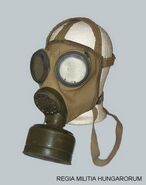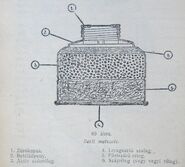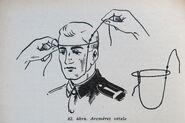(filter info) Tag: Visual edit |
(tan--->light brown) Tag: Visual edit |
||
| Line 16: | Line 16: | ||
== Overview == |
== Overview == |
||
| − | It is a full face mask made of rubber coated light brown canvas (after the war green canvas was used). The shatterpoof (itself is composed of two glass layers and a thin sheet of cellulose) eyepieces are in copper assemblies with antifog insert fixing metal C-rings. The harness uses a three-piece adjustable harness hooked up to a small leather center-piece the straps are bolted onto, an additional strap near the bottom would be wrapped around the user's head and hooked around to provide a tight seal. There is a carrying strap on the bottom back of the mask. The valves are in one green painted aluminium alloy piece. The exhale is on top of the 40mm intake (the thread is very loose, GOST filters can easily fit in and seals with the mask). Unlike the Cold War Hungarian masks the size 1 is the biggest and size 4 is the smallest. |
+ | It is a full face mask made of rubber coated light brown canvas (after the war green canvas was used). The shatterpoof (itself is composed of two glass layers and a thin sheet of cellulose) eyepieces are in copper assemblies with antifog insert fixing metal C-rings. The harness uses a three-piece adjustable harness hooked up to a small leather center-piece the straps are bolted onto, an additional strap near the bottom would be wrapped around the user's head and hooked around to provide a tight seal. There is a carrying strap on the bottom back of the mask. The valves are in one dark olive green painted aluminium alloy piece. The exhale is on top of the 40mm intake (the thread is very loose, GOST filters can easily fit in and seals with the mask). Unlike the Cold War Hungarian masks the size 1 is the biggest and size 4 is the smallest. |
== Filter == |
== Filter == |
||
| Line 36: | Line 36: | ||
Telling the era of the mask is the easiest from the painting, but it is not a sure method because after the war the useable masks were re issued with new painting. Using the stamps and other markings is not the best way as well to identify when the mask was made because after the war masks in good condition were reissued with new markings. So it can occur that a mask that was made befor the war has communist markings. |
Telling the era of the mask is the easiest from the painting, but it is not a sure method because after the war the useable masks were re issued with new painting. Using the stamps and other markings is not the best way as well to identify when the mask was made because after the war masks in good condition were reissued with new markings. So it can occur that a mask that was made befor the war has communist markings. |
||
===War models=== |
===War models=== |
||
| − | The war production masks have dark olive- |
+ | The war production masks have dark olive-brown (or on the late war models light brown) colored valves which are non-magnetic while the eyepiece assembiles are made of copper and painted black or on the late war models light brown and made of magnetic steel alloy. The 42M carrying canisters are light brown (soldier slang "liba" - goose) colored not green and always has metal hook to fix the box to the belt. The Civil defence variants have unpainted raw copper eyepiece assemblies and came in the 34M bag or 42M "hópihe" canister. |
===Post war models=== |
===Post war models=== |
||
The post war variants are much more diverse. On the early ones every metal parts (valve housing, eyepiece assemblies, filter, carrying canister) are painted with green color. And to reduce costs steel alloy (magnetic) was used instead of copper (non-magnetic) wich is expensive. The later ones has black rubber inside and sometimes come in the dark green colored canvas on the outside. Those are usually lacking of painted metal parts which are mostly aluminium and steel alloy. Masks with black painted metal parts usually with black rubber inside, those are made mostly for the industry. Small differences can occur. |
The post war variants are much more diverse. On the early ones every metal parts (valve housing, eyepiece assemblies, filter, carrying canister) are painted with green color. And to reduce costs steel alloy (magnetic) was used instead of copper (non-magnetic) wich is expensive. The later ones has black rubber inside and sometimes come in the dark green colored canvas on the outside. Those are usually lacking of painted metal parts which are mostly aluminium and steel alloy. Masks with black painted metal parts usually with black rubber inside, those are made mostly for the industry. Small differences can occur. |
||
Revision as of 19:41, 12 September 2019
The Hungarian 34M was designed before the Second World War and was used untill the end of the 1990’s in some form. Originally it was issued to the Magyar Királyi Honvédség (Hungarian Royal Army), Légoltalmi Liga (predecessor of the Polgári védelem - Civil Defence) after the war to the Magyar Néphadsereg (Hungarian People’s Army) later it was also used by the Polgári védelem (Civil Defence).
Overview
It is a full face mask made of rubber coated light brown canvas (after the war green canvas was used). The shatterpoof (itself is composed of two glass layers and a thin sheet of cellulose) eyepieces are in copper assemblies with antifog insert fixing metal C-rings. The harness uses a three-piece adjustable harness hooked up to a small leather center-piece the straps are bolted onto, an additional strap near the bottom would be wrapped around the user's head and hooked around to provide a tight seal. There is a carrying strap on the bottom back of the mask. The valves are in one dark olive green painted aluminium alloy piece. The exhale is on top of the 40mm intake (the thread is very loose, GOST filters can easily fit in and seals with the mask). Unlike the Cold War Hungarian masks the size 1 is the biggest and size 4 is the smallest.
Filter
Main article: 34M filter
First it was issued with a big flat canister filter (28M filter) and hose. Later a lightweight filter was issued. The 34M filter come in a cylindrical canister with a cap and sticker sealing the bottom. The filter was redeveloped in 1941 because during the Hungarian invasion of the Soviet Union the troops have found Zinc arsenate (Zn3(AsO4)2) powder in warehouses which is used to produce Arsine (AsH3). Arsine was used as a toxic agent and the filter of the 34M was useless against it. So the army would have been suffered heavy loses in case of a gas attack. The redeveloped filters which were protected against arsine were marked with an “A” on the top of the filter.
Bag and kit
The 34M bag is made of canvas with a leather bottom. The little pocket under the lid is for the spere antifog inserts.
Later the canvas bag was changed to the 42M metal cylinder box in lined with cardboard (very similar to the German one). It has a metal frame on the inside lid which is for the antifog membranes and Gázseb-csomag (Gas wound kit - decontamination kit).
The kit contained:
- 34M facepiece
- 34M filter
- 34M bag or 42M cylinder box
- antifog inserts (one pair in the eyepieces and one spare pair)
Variants
Telling the era of the mask is the easiest from the painting, but it is not a sure method because after the war the useable masks were re issued with new painting. Using the stamps and other markings is not the best way as well to identify when the mask was made because after the war masks in good condition were reissued with new markings. So it can occur that a mask that was made befor the war has communist markings.
War models
The war production masks have dark olive-brown (or on the late war models light brown) colored valves which are non-magnetic while the eyepiece assembiles are made of copper and painted black or on the late war models light brown and made of magnetic steel alloy. The 42M carrying canisters are light brown (soldier slang "liba" - goose) colored not green and always has metal hook to fix the box to the belt. The Civil defence variants have unpainted raw copper eyepiece assemblies and came in the 34M bag or 42M "hópihe" canister.
Post war models
The post war variants are much more diverse. On the early ones every metal parts (valve housing, eyepiece assemblies, filter, carrying canister) are painted with green color. And to reduce costs steel alloy (magnetic) was used instead of copper (non-magnetic) wich is expensive. The later ones has black rubber inside and sometimes come in the dark green colored canvas on the outside. Those are usually lacking of painted metal parts which are mostly aluminium and steel alloy. Masks with black painted metal parts usually with black rubber inside, those are made mostly for the industry. Small differences can occur.
Service
- Magyar Királyi Honvédség (Hungarian Royal Army) (1934-1945): The standard issue gas mask for the army. The chemical troops used the mask with Gázvédőruha (gas protection suit).
- Légoltalmi liga (Civil Defence) (1934-1945): The Civil Defence used the mask as M. gázálarc mostly with the 28M filter and hose, it was issued to registered memebers and clean up crews alongside with the Gumi munkagázálarc.
- Magyar Honvédség (Hungarian army) (1946-1951): The mask was again the standard issue gas mask for the army alongside with the post war models. The chemical troops used it with the same chemical suit as in the war. In 1949 there were 87639 pcs. in stock.
- Polgári védelem (Civil Defence) (1946-1950s): Gas mask for registered members.
- Magyar Néphadsereg (Hungarian People's Army) (1951-late 1950s): After the short lived democratic army and the communist takeover the army was renamed and a lot of thing changed but the mask was in service until the late 1950s (til enough 51M masks were made).
- The industry used post war models until the 1960s. The factory based emergency frefighter warehouses stored the model even before the regime change.
External information
Price
The mask costed 14 Pengő (the whole kit was 25 Pengő) in 1936 which is nothing compared to the price of the 28M whit its 113 Pengő price (the Népgázálarc was 13 Pengő).
Manufacturers
Befor and during the war the facepiece, bag and filter was made by Mercur Műszaki és Vegyipari Rt. in Budapest. The activated charcoal was provided by IPTER Műszéntermelő Vállalat, the rubber coated canvas was made by Ruggyantaárugyár and the canvas for the bag was manufactured by Szegedi Len- és Kendergyár. Ony the antifog inserts were made abroad by Auer in Berlin. Just after the war nothing changed but after the communist takeover Mercur was renamed to 1004. sz. Vállalat (1004th company) and later to Medicor.
Other pictures
References
- Légoltalmi radiológiai-biológiai-vegyvédelmi alapismeretek (book-1965)
- Légoltalmi ismeretek a lakóházi (önvédelmi) szervek részére II. kiadás (book-1952)
- Horler Ferenc: A polgári lakosság önvédelme légitámadások ellen (book-1938)
- http://militiahungarorum.roncskutatas.com/1920_e_f_g_4.html
- http://gasmask1.kalasnyikov.hu/masks/m34/m34.htm#M%C3%A1sodik%20vil%C3%A1gh%C3%A1bor%C3%BA%20ut%C3%A1ni%20v%C3%A1ltozat
- http://www.fortepan.hu/?search=g%C3%A1z%C3%A1larc
- https://drive.google.com/file/d/1XOoEz8_g2QLq6zZ9FSq8Q3uEEAi2vQOG/view
- Magyar atom-, biolódiai- és vegyi- (ABV) védelmi technikai almanch (2003)
- http://maski.poszukiwania.pl/index.php/en/wegry
- https://drive.google.com/file/d/0B2IT5sLzLGdDeUdtM3pGVzFfS0E/view


























